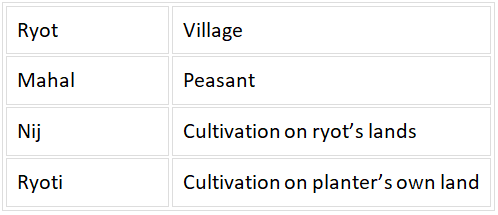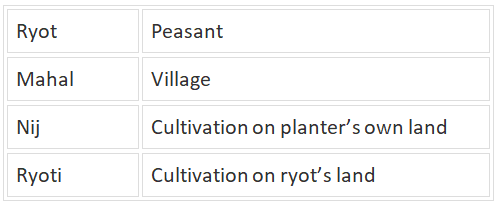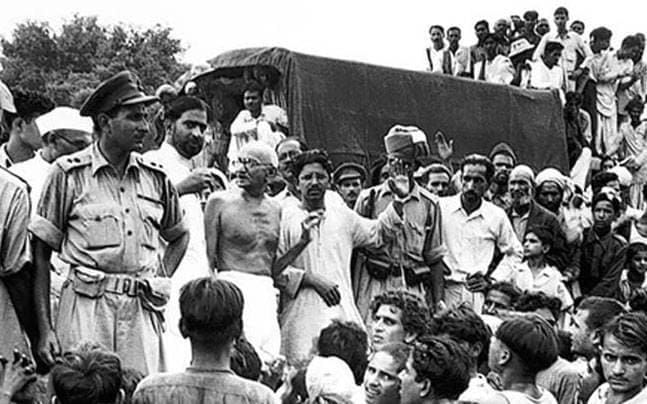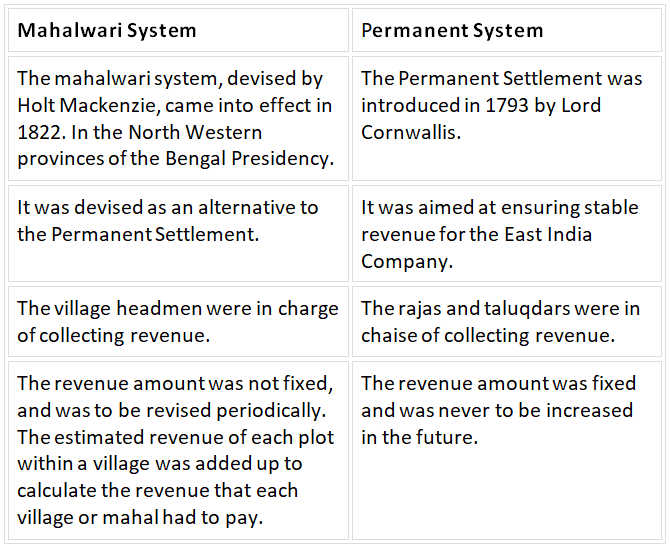NCERT Solutions for Class 8 History Chapter 3 - Ruling the Countryside
Let's recall
Q1. Match the following:
Ans:
Q2. Fill in the blanks:
(a) Growers of woad in Europe saw __________ as a crop which would provide competition to their earnings.
Ans: Growers of woad in Europe saw indigo as a crop which would provide competition to their earnings.
(b) The demand for indigo increased in late eighteenth-century Britain because of __________.
Ans: The demand for indigo increased in late eighteenth-century Britain because of the expansion of cotton production.
(c) The international demand for indigo was affected by the discovery of __________.
Ans: The international demand for indigo was affected by the discovery of synthetic dyes.
(d) The Champaran movement was against __________.
Ans: The Champaran movement was against indigo planters.
 Champaran Movement.
Champaran Movement.
Let's Discuss
Q3. Describe the main features of the Permanent Settlement.
Ans: In order to get a stable revenue income, most of the East India Company’s officials believed that investment in land had to be encouraged and agriculture had to be improved. This led to introduction of permanent settlement in 1793.
 Land Revenue Policy.
Land Revenue Policy.
- By the terms of the settlement the rajas and taluqdars were recognized as zamindars.
- They were asked to collect rent from the peasants and pay revenue to the company.
- The amount to be paid was fixed permanently.
- It was felt that this would ensure a regular flow of revenue into the company’s coffers and at the same time encourages the zamindars to invest is improving the land.
- If the zamindars failed to pay the revenue, which they usually did as the fixed revenue was very high, they lost their zamindari.
Q4. How was the mahalwari system different from the Permanent Settlement?
Ans:
Q5. Give two problems which arose with the new Munro system of fixing revenue.
Ans: Two problems which arose with the new Munro system of fixing revenue were:
- Driven by the desire to increase the income from land, revenue officials fixed too high a revenue demand.
- Peasants were unable to pay ryots fled the countryside and villages became deserted in many regions.
Q6. Why were ryots reluctant to grow indigo?
Ans: The ryots reluctant to grow indigo because:
- The planters paid a very low price for indigo.
- The ryots were not in a position to even recover his cost, earning a profit was a far-fetched idea. This meant that the ryot was always under debt.
- The planters insisted that the peasants cultivate indigo on the most fertile parts of their land, but the peasants preferred growing rice on the best soils as after an indigo harvest, the land could not be used for sowing rice.
Q7. What were the circumstances which led to the eventual collapse of indigo production in Bengal?
Ans: The collapse of indigo production in Bengal was caused by the following circumstances:
- Ryots’ denied producing the indigo anymore
- Protests started taking place by the peasants/ ryots supported by the zamindars
- Following the protests, the Indigo Commission was constituted by the government which accepted the faults of the planters and asked the planters to stop the cultivation.
- Planters eventually moved out of the city
 Indigo production in Bengal.
Indigo production in Bengal.
Let's Do
Q8. Find out more about the Champaran movement and Mahatma Gandhi’s role in it.
Ans: The Champaran Movement
- Where and When: The Champaran movement took place in the Champaran district of Bihar in 1917.
Cause of the Movement:
1. British planters forced peasants (farmers) to grow indigo on a part of their land.
2. Peasants were required to give a share of the crop to the British landlords at very low prices.
3. Farmers faced high rents, debts, and harsh treatment.
4. They had no right to refuse, which caused widespread distress.Nature of the Movement:
This was the first major Satyagraha (non-violent protest) led by Mahatma Gandhi in India.
It was not violent but involved peaceful protests, fact-finding, and negotiations.
Mahatma Gandhi’s Role
- Invitation to Champaran: Gandhi was asked by local peasants and leaders to investigate the condition of the farmers.
1. Gandhi visited the villages and talked to the peasants directly.
2. He collected evidence of exploitation and injustices. Protests and Satyagraha:
Gandhi organised peaceful protests and negotiations with British authorities.
He insisted on truth and justice rather than violence.
Q9. Look into the history of either tea or coffee plantations in India. See how the life of workers in these plantations was similar to or different from that of workers in indigo plantations.
Ans: Similarities
- Coercion & control: Both faced pressure from planters and intermediaries.
- Economic exploitation: Low returns (indigo through unfair contracts; tea through low wages/fines).
- Harsh conditions: Long hours, poor housing/health, physical intimidation common.
- Debt/Advances: Advances kept both groups dependent on planters/contractors.
Differences

|
87 videos|558 docs|53 tests
|
FAQs on NCERT Solutions for Class 8 History Chapter 3 - Ruling the Countryside
| 1. What was the impact of British land revenue policies on Indian peasants? |  |
| 2. How did the Permanent Settlement system work in India? |  |
| 3. What was the role of the Zamindars in the British revenue system? |  |
| 4. How did the British revenue system lead to the growth of commercial agriculture in India? |  |
| 5. What was the impact of the British land revenue policies on the Indian economy? |  |

















